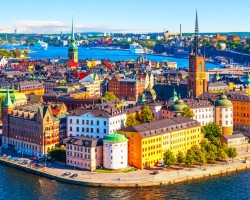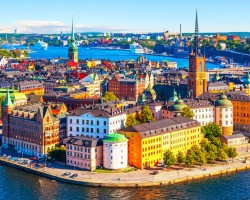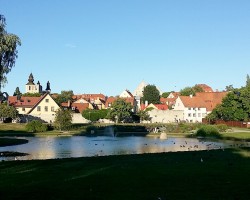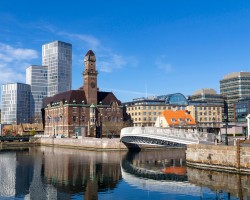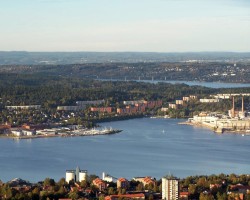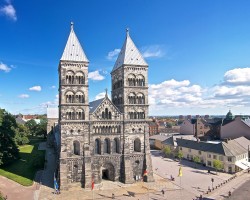Best time to go to Sweden for a perfect weather and where to go?
When is the best time to go to Sweden?
The best time to visit Sweden is in the summer, between June and September, but a trip all year round is possible, depending on the experiences you wish to have on site.
- For a city break of a few days in Stockholm, prefer the months between April and October. It can be cool, even cold, in spring and autumn, but if you have a tight budget, the capital is then much more affordable and the weather conditions remain acceptable. Also known as the "Venice of the North", it allows for discoveries placed under the sign of the sweetness of life. From June to August, it's the perfect time to go on a mini-cruise on its clear waters of the archipelago. You can explore many islands with colorful habitats and immerse yourself in Swedish culture.
- When is the best time to go to Sweden for memorable hikes in communion with nature and to enjoy outdoor activities? Opt for summer, between June and September. At the beginning of the season, rain may come, but the days are longer. However, autumnal weather arrives from mid-August and the atmosphere cools down, which is largely compensated by the forest landscapes adorned with surreal colors. The best compromise is to go to Sweden in July.
- For swimming, the warmest months are July and August. However, this activity is mainly for the bravest, as the sea temperature rarely rises above 19°C, and generally hovers around 17°C. Good to know: lake water is always a bit warmer! And to warm up, nothing beats a good traditional sauna...
- To see the midnight sun, it all depends on the latitude: north of the Arctic Circle, it is visible 24 hours a day from mid-May to July 20 and from early June to mid-July for cities slightly below the circle. Conversely, during winter, from December to March, it is almost always night in this area. In the southern part of Sweden, you won't see the midnight sun, but the days are still very long, with for example 18 hours on July 1st in Stockholm.
- If you dream of admiring the Northern Lights, the ideal period is from February to April, when nights are long and the sky is often clear. The further north you are, the more chances you have to see this fascinating natural spectacle.
- For skiing or dog sledding, the season runs from December to April in central Sweden and from March to early June in the north.
What to pack in your suitcase for a trip to Sweden? Regardless of when you go, remember to bring a swimsuit and good sunscreen. In winter, and even in the shoulder seasons depending on the latitude, take a whole set of warm clothes using the layering technique with several layers, finishing with a warm and waterproof coat. Good waterproof hiking shoes, wool socks, gloves, and a hat are also essential. The rest of the year, always have a jacket to protect you from the rain and comfortable clothes for strolling around.
This text has been automatically translated.
Where and when to go based on the weather?
Götaland (South)
Gothenburg, Malmo, Gotland...
Norrland (North)
Sundsvall, Gävle, Skellefteå...
Svealand (Center)
Stockholm, Uppsala, Karlstad...
To get all the information about the climate and weather in Sweden for a specific month, click on the corresponding link below:
Sweden in january Sweden in february Sweden in march Sweden in april Sweden in may Sweden in june Sweden in july Sweden in august Sweden in september Sweden in october Sweden in november Sweden in december
Best time to travel to Sweden by cities
Climate and Weather in Sweden
Thanks to the Gulf Stream, Sweden's climate is temperate despite its northern position. Stretched from north to south, the country has three main variants:
- An oceanic climate with mild summers is predominant. It can be found in Gothenburg and in a large part of the south, as well as around Nyköping in the center of the country.
- A humid continental climate with mild and dry-less seasons is present in Central Sweden, especially in the Stockholm region, but also towards Norrkoping in the south and Gävle in the north.
- A subarctic climate with cold winters prevails over almost all of northern Sweden, such as in Sundsvall. It is also found around Lake Siljan in the central region.
Like all European countries, Sweden has four seasons:
- Summer varies in duration depending on the location. In the north, it arrives rather abruptly in June, and ends just as suddenly around mid-August. In the center and south, it arrives more gradually and lasts longer, often until mid-September. It is worth noting that with global warming, this season tends to lengthen throughout the country. Surprisingly, temperatures are comparable from north to south, and it is the season with the most rainfall.
- Spring and autumn are quite short: they are essentially limited to the months of May and November. During these times of the year, the atmosphere is cool and humid.
- Winter lasts about 7 months in northern Sweden, from October to April, and maximum temperatures are almost always negative in this region. In the center and south, the thermometer offers more pleasant averages, but snow is still often present between December and March, especially inland.
The weather in Sweden is marked by great instability, especially in summer. It is not uncommon to experience several weather changes in a single day and significant temperature variations from one hour to the next. Moreover, the temperature range is very significant between summer and winter, especially in the north where the difference can be over 30°C!

Climate in Götaland (Southern Sweden) and Svealand (Central Sweden)
Even though the climate in Götaland is mainly oceanic and in Svealand humid continental, the weather in these two regions is quite similar.
- The best time to visit is from June to September, during the summer. This season has many rainy days, but the temperatures are mild. Expect temperatures between 19 and 22°C during the day and between 15 and 17°C at night until August, then around 4°C lower in September. Norrkoping and Uppsala are the warmest, with temperatures reaching close to 25°C in July. During this period, the daylight is exceptional and lasts up to 18 hours a day.
- In spring, the temperature gradually rises: it ranges from 8 to 11°C in April, and from 14 to 16°C in May. Precipitations are quite reasonable, but when it rains, the humidity accentuates the feeling of coolness. Autumn has similar characteristics, but reversed: in October, the highs range from 10 to 13°C, then drop to between 5 and 9°C in November.
- Winter is quite harsh in this part of Sweden. Temperatures range from 3 to 6°C in December as in March, while January and February are the coldest months of the year with highs around 0°C.
Climate in Norrland (Northern Sweden)
In northern Sweden, only the months from June to August are favorable weather-wise. During this time, temperatures range from 20 to 23°C during the day! Precipitations are slightly lower than in the central and southern parts of the country, with July being the rainiest month.
In September, a trip is still possible as temperatures hover around 17°C. From October, the thermometer drops to an average of 10°C during the day and 0°C at night, marking the appearance of the first snow.
Between November and March, winter is in full swing and can be very harsh in some areas. While daily averages range from -11 to 5°C, temperatures can drop to as low as -30°C above the Arctic Circle. Despite being icy, the season is quite dry.
In April and May, temperatures are still below freezing in Kebnekaise, but gradually rise further south. In Sundsvall, expect averages around 7°C in April and 13°C in May.
This text has been automatically translated.
Temperatures and rainfall in Sweden
On these 3 graphs, we present the evolution of temperatures of Sweden and month-by-month rainfall for the cities of Stockholm, Gothenburg, Gävle, Gotland and Karlstad, as well as the month-by-month sea temperature for coastal cities.
Peak visitor numbers and tourist seasons in Sweden
Find out when Sweden has its high tourist season (the period when the influx of tourists is highest) and off-peak tourist season using our data and figures.
Tourist seasons in Sweden
The months with low numbers of tourists are: January, February, March, April, May, September, October, November and December. The number of visitors to Sweden is high in: June, July and August.
- Very low season in Sweden: January, February, March, October and November.
- Low season in Sweden: April, May, September and December.
- High season in Sweden: June.
- Peak season in Sweden: July and August.
Figure: Visitor index for Sweden month by month
Average price for flights to Sweden
A return flight between New York City and Stockholm is generally cheaper if you go in january ($ 546 on average): this is the best time for travellers on a tight budget. In contrast, you may end up paying $ 507 more for your airline ticket to Stockholm if you go in july.
Where to go in Sweden?
This table allows you to see the maximum temperature for each city and our opinion on the weather month by month (see colour legend below the table).
| Cities | jan. | feb. | mar. | apr. | may | jun. | jul. | aug. | sep. | oct. | nov. | dec. |
| Stockholm | 32°F | 34°F | 40°F | 50°F | 59°F | 67°F | 72°F | 70°F | 63°F | 50°F | 43°F | 36°F |
| Gothenburg | 36°F | 36°F | 41°F | 50°F | 59°F | 65°F | 70°F | 68°F | 63°F | 54°F | 47°F | 40°F |
| Gävle | 31°F | 32°F | 38°F | 50°F | 61°F | 68°F | 74°F | 70°F | 63°F | 50°F | 41°F | 34°F |
| Gotland | 36°F | 36°F | 40°F | 47°F | 54°F | 63°F | 68°F | 68°F | 61°F | 52°F | 47°F | 41°F |
| Karlstad | 32°F | 32°F | 40°F | 50°F | 59°F | 67°F | 72°F | 68°F | 63°F | 52°F | 43°F | 36°F |
| Malmo | 38°F | 38°F | 43°F | 52°F | 59°F | 67°F | 70°F | 70°F | 65°F | 56°F | 49°F | 41°F |
| Skellefteå | 25°F | 25°F | 32°F | 41°F | 54°F | 63°F | 68°F | 67°F | 58°F | 45°F | 36°F | 31°F |
| Sundsvall | 27°F | 29°F | 34°F | 45°F | 56°F | 65°F | 70°F | 67°F | 58°F | 47°F | 38°F | 32°F |
| Uppsala | 31°F | 32°F | 40°F | 50°F | 61°F | 68°F | 74°F | 70°F | 63°F | 50°F | 41°F | 34°F |
| Fårö island | 38°F | 36°F | 38°F | 43°F | 50°F | 59°F | 67°F | 67°F | 61°F | 52°F | 47°F | 41°F |
| Fiskebäckskil | 38°F | 36°F | 41°F | 47°F | 56°F | 61°F | 67°F | 67°F | 61°F | 54°F | 47°F | 41°F |
| Fjällbacka | 36°F | 34°F | 41°F | 50°F | 58°F | 65°F | 68°F | 67°F | 61°F | 52°F | 45°F | 40°F |
| Hållö island | 38°F | 36°F | 41°F | 47°F | 56°F | 61°F | 67°F | 67°F | 61°F | 54°F | 47°F | 41°F |
| Kebnekaise | 13°F | 16°F | 23°F | 32°F | 38°F | 52°F | 61°F | 58°F | 49°F | 32°F | 23°F | 18°F |
| Kullaberg | 38°F | 38°F | 41°F | 50°F | 58°F | 65°F | 68°F | 68°F | 63°F | 56°F | 49°F | 43°F |
| Lund | 38°F | 38°F | 43°F | 52°F | 61°F | 68°F | 72°F | 70°F | 65°F | 56°F | 47°F | 41°F |
| Norrkoping | 32°F | 34°F | 41°F | 52°F | 61°F | 70°F | 74°F | 72°F | 63°F | 52°F | 43°F | 36°F |
| Öland | 36°F | 36°F | 41°F | 50°F | 59°F | 67°F | 72°F | 70°F | 65°F | 54°F | 47°F | 40°F |
| Ostersund | 23°F | 25°F | 31°F | 41°F | 54°F | 63°F | 68°F | 65°F | 56°F | 43°F | 34°F | 29°F |
| Sandhamn | 34°F | 34°F | 38°F | 45°F | 52°F | 61°F | 67°F | 67°F | 61°F | 50°F | 45°F | 38°F |
Legend:
perfect weather
good weather
tolerable weather
bad weather
very bad weather
About Sweden
What can I do in Sweden?
Beaches / swimming
Nature and countryside
Culture and heritage
Sports
Family travel
Crafts / shopping
Gastronomy
Nightlife
Is this weather information for Sweden reliable?
Climate data for Sweden has been gathered every day since January 2009. The analysis of these meteorological data for Sweden allows us to determine the average for each month in Stockholm, Gothenburg, Gävle, Gotland, Karlstad, Malmo, Skellefteå, Sundsvall, and 97 other cities.
So yes: this data is reliable except in cases of temporary climate disruption in the region.

